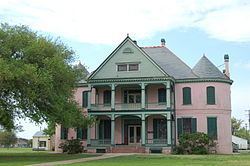Area less than one acre NRHP Reference # 74002188 Added to NRHP 18 January 1974 | Built 1858 (1858) Opened 1858 | |
 | ||
Similar Bayou Terrebonne Waterlife, Terrebonne Folklife Culture C, Regional Military Museum, Ardoyne Plantation House, TERREBONNE HISTORICAL & CULTU | ||
Southdown plantation tours a must see museum in houma la
Southdown Plantation is a historic Southern plantation in Terrebonne Parish, Louisiana.
Contents
- Southdown plantation tours a must see museum in houma la
- Amazing candy art at southdown plantation in houma
- Founding and early history
- Modern era
- References
Amazing candy art at southdown plantation in houma
Founding and early history
Southdown Plantation was founded in 1828 by Stephen Minor, former secretary to the Spanish Governor of Louisiana, Manuel Gayoso de Lemos. The land had first been a Spanish land grant and was later owned by brothers Jim and Rezin Bowie, who began planting and harvesting indigo there. Minor purchased the land, approximately 1,020 acres, together with James Dinsmore. In 1831, sugarcane became the principle crop, and the first sugar mill was built in 1846. By 1852, Southdown was home to 233 slaves, most of whom lived in family units on the property.
The first plantation house was built by Minor's son, William J. Minor, in 1858, and was named for a breed of sheep that the family raised. The house was built of hand-fired brick and wood from cypress and pine trees that grow in the area.
The original one-story brick home was expanded in 1893, when a second story and Virginia style colonnaded walkways were added. In the same year, Favrile glass panels depicting the plantation, palmetto leaves, magnolia branches, and sugar cane stalks were installed in the house. The plantation consisted of over 10,000 acres of sugar cane fields, a sugar mill, and a race track. Southdown Plantation was instrumental in launching and sustaining the sugar industry in the area, ensuring the survival of the crop by developing a variety of sugar cane that was resistant to mosaic disease.
The Minor family was known for frequently entertaining guests and hosting many extravagant balls and receptions.
Modern era
During the Great Depression, the Minor family lost ownership of the house. In 1979, the Southdown sugar mill was closed, and its parts were shipped to and reassembled in Guatemala, where it continued operation. It was the last of the 86 sugar mills that had operated in Terrebonne Parish during the sugar boom of the 19th century.
In 1974, the plantation was added to the National Register of Historic places, and in the following year, the property was donated to the Terrebonne Historical and Cultural Society by Valhi, Incorporated, a subsidiary of Southdown Sugar. While the plantation house was being renovated, the original 1893 pink and green paint scheme was discovered and restored to the walls. On June 27, 1982, the plantation house and servants' quarters were open to the public as a museum.
